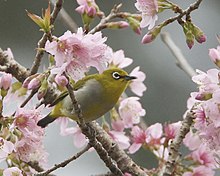Prunus cerasoides
| Prunus cerasoides | |
|---|---|

| |
| Indian white-eye in a wild Himalayan cherry | |
| Scientific classification | |
| Kingdom: | Plantae |
| Clade: | Tracheophytes |
| Clade: | Angiosperms |
| Clade: | Eudicots |
| Clade: | Rosids |
| Order: | Rosales |
| Family: | Rosaceae |
| Genus: | Prunus |
| Subgenus: | Prunus subg. Cerasus |
| Species: | P. cerasoides
|
| Binomial name | |
| Prunus cerasoides | |
| Synonyms[2] | |
| |
Prunus cerasoides, called the wild Himalayan cherry and sour cherry,[3] is a deciduous cherry tree found in East Asia, South Asia and Southeast Asia. It is of the family Rosaceae and the genus Prunus.
Its range extends in the Himalayas from Himachal Pradesh in north-central India, to Southwest China, Burma and Thailand. It grows in temperate forest from 1,200–2,400 metres (3,900–7,900 ft) in elevation.[4]
Description[]
Prunus cerasoides is a tree which grows up to 30 metres (98 ft) in height. It has glossy, ringed bark. When the tree is not in flower, it is characterised by glossy, ringed bark and long, dentate stipules.
The tree flowers in autumn and winter. Flowers are hermaphroditic and are pinkish white in color. It has ovoid yellow fruit that turns red as it ripens.
Uses[]
Cultivation[]
Prunus cerasoides is cultivated as an ornamental tree. The tree thrives in well-drained and moisture-retentive loamy soil, in an open, sunny, and sheltered location.
P. cerasoides, like most members of the genus Prunus, is shallow rooted and is likely to produce suckers if the root is damaged. It is likely to become chlorotic if too much lime is present. It is known to be susceptible to honey fungus.
The seed requires two to three months cold stratification and is best sown in a cold frame as early in winter as possible. The seed grows rather slowly and can sometimes take about 18 months to germinate depending on the conditions.
Food[]
- Fruit — 15mm in diameter, the fruit can be eaten raw or cooked.
- Gum — Gum is chewed and obtained from the trunk. It can be employed as a substitute for gum tragacanth.
- Seed — It can be eaten raw or cooked.
Other uses[]
The fruits and the leaves give a dark green dye. Seeds can be used in the manufacture of necklaces.
The wood is hard, strong, durable and aromatic, and branches are used as walking sticks.
| Wikimedia Commons has media related to Prunus cerasoides. |
References[]
- ^ "Plant Name Details for Prunus cerasoides D.Don". IPNI. Retrieved September 16, 2009.
- ^ See Taxonbar
- ^ "Prunus cerasoides". Germplasm Resources Information Network (GRIN). Agricultural Research Service (ARS), United States Department of Agriculture (USDA). Retrieved January 24, 2014.
- ^ Chandel, V.; Rana, T.; Hallan, V.; Zaidi, A. A. (2007). "Wild Himalayan Cherry (Prunus cerasoides) as a Natural Host of Prunus necrotic ringspot virus in India". Plant Disease. 91 (12): 1686. doi:10.1094/PDIS-91-12-1686C. PMID 30780621.
External links[]
- Prunus
- Cherries
- Sour fruits
- Trees of China
- Flora of the Indian subcontinent
- Flora of Indo-China
- Garden plants of Asia
- Ornamental trees
- Plants described in 1825